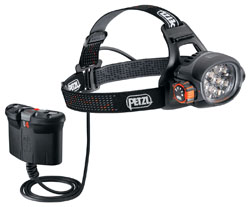A couple of small but indispensable items on the course included Sea to Summit’s eVAC Dry Sacks and the Platy SoftBottle water containers from Cascade Designs Inc. The dry sacks — which are waterproof storage bags in which I kept all gear inside my backpack — have an eVent fabric bottom that lets air out. You roll up the top like a regular waterproof bag. But instead of having to carefully get the air out, you can simply pressure the bag to force air inside through the eVent fabric. (It lets air out but keeps water from coming in.) I used the 13-liter ($22.95) and 20-liter ($28.95) size sacks.

For carrying extra water, instead of bottles my team got Platy SoftBottles, which are lightweight, flexible plastic bladders with screw-shut caps. They hold one liter of water apiece and then roll up to almost nothing when empty. Cost is $13 per Platy bottle.

Illumination at night came from two main sources. The ULTRA headlamp from Petzl, a ridiculously bright unit that costs $500, is rated to shine at 350 lumens. It sends a cone of white light from your forehead into the night, creating a virtual window of daylight. The battery pack, a beefy rechargeable unit, is connected via a long cord and must be stored in a pocket or backpack pouch. We used the ULTRA on several nights while racing, and the Petzl’s beam provided a huge range of vision when it was pitch black.

The smaller Princeton Tec EOS headlamp was my primary light source. It is a “normal” headlamp, meaning it’ll light a trail and the surrounding area enough to hike and move in a dark woods, though it won’t burn the trail like the ULTRA. It is a lightweight unit that runs off of three AAA batteries. I have used previous generations of this model and love its efficiency and comfortable fit on the head. It’s rated to produce 70 lumens of brightness. Cost is $44.99.

Two gadgets we had in our packs the whole trip — but were not allowed to use in less there was an emergency — were a satellite phone and a GPS unit. The race organization provided the sat phone. Each team brought their own GPS, and we went with the Earthmate PN-40 from DeLorme. The $349.95 unit was never used on the course, but my team got to know the GPS unit pre-race. It has a solid build and easy operation. A bonus with DeLorme: The company has a huge selection of maps and aerial imagery available to download onto its GPS units. Some of this would’ve been nice when we were stumbling in Patagonia. But on the race, only a map and compass were allowed.

Finally, my helmet: The Kong Scarab has become a hugely popular lid with adventure racers because it is certified for multiple disciplines. Racers can use the helmet, which costs $149.95 and is distributed by Liberty Mountain in the United States, for biking, climbing, and kayaking. (The company has also had it certified for sports like skateboarding and horseback riding.) In Patagonia, the plan was to have one helmet the whole trip. We’d use it in the mountains climbing as well as for biking legs.

Though its do-all build makes some compromises — e.g., it’s not as vented as you’d like a bike helmet to be — the Scarab fits well and feels solid. It weighs about 255 grams, which is so light as to be almost unnoticeable strapped on a pack. But the best part with the Scarab is its usability among various sports. In the Patagonia race, it was a small but crucial part of the kit of equipment that allowed me to make it through the course, across Tierra del Fuego, and back home to civilization again.
—Stephen Regenold is founder and editor of www.gearjunkie.com. Go to www.gearjunkie.com/patagonian-race for additional reports and photos from the 2010 Wenger Patagonian Expedition Race.








